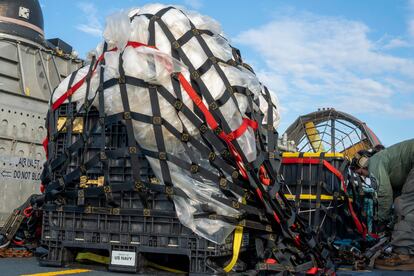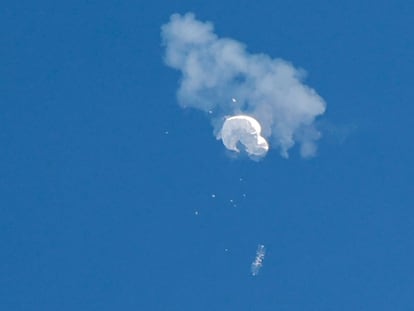Military finishes recovering Chinese balloon debris
Analysis of the debris so far reinforces conclusions that it was a Chinese spy balloon, U.S. officials said

The U.S. has finished efforts to recover the remnants of the large balloon that was shot down off the coast of South Carolina, and analysis of the debris so far reinforces conclusions that it was a Chinese spy balloon, U.S. officials said Friday. Officials said the U.S. believes that Navy, Coast Guard and FBI personnel collected all of the balloon debris off the ocean floor, which included key equipment from the payload that could reveal what information it was able to monitor and collect.
U.S. Northern Command said in a statement that the recovery operations ended Thursday and the final pieces are on their way to the FBI lab in Virginia for analysis. It said air and maritime restrictions off South Carolina have been lifted.
The announcement capped three dramatic weeks that saw U.S. fighter jets shoot down four airborne objects — the large Chinese balloon on Feb. 4 and three much smaller objects about a week later over Canada, Alaska and Lake Huron. They are the first known peacetime shootdowns of unauthorized objects in U.S. airspace.
The officials also said the search for the small airborne object that was shot down over Lake Huron has stopped, and nothing has been recovered. U.S. officials spoke on condition of anonymity to discuss military operations. The U.S. and Canada have also failed to recover any debris so far from the other two objects which were shot down over the Yukon and northern Alaska.
While the military is confident the balloon shot down off South Carolina was a surveillance airship operated by China, the Biden administration has admitted that the three smaller objects were likely civilian-owned balloons that were targeted during the heightened response, after U.S. homeland defense radars were recalibrated to detect slower moving airborne items.
Due to their small size and the remote areas where they were shot down, officials acknowledge that recovering any debris is difficult and probably unlikely. Those last two searches, however, have not been formally called off.
Much of the Chinese balloon fell into about 50 feet (15 meters) of water, and the Navy was able to collect remnants floating on the surface, and divers and unmanned naval vessels pulled up the rest from the bottom of the ocean. Northern Command said Friday that all of the Navy and Coast Guard ships have left the area.
On Thursday, President Joe Biden directed national security adviser Jake Sullivan to lead an interagency team to establish “sharper rules” to track, monitor and potentially shoot down unknown aerial objects.
Meanwhile, key questions about the Chinese balloon remain unanswered, including what, if any, intelligence it was able to collect as it flew over sensitive military sites in the United States, and whether it was able to transmit anything back to China.
The U.S. tracked it for several days after it left China, said a U.S. official, who spoke to The Associated Press on condition of anonymity to discuss sensitive intelligence. It appears to have been blown off its initial trajectory, which was toward the U.S. territory of Guam, and ultimately flew over the continental U.S., the official said.
Balloons and other unidentified objects have been previously spotted over Guam, a strategic hub for the U.S. Navy and Air Force in the western Pacific.
It’s unclear how much control China retained over the balloon once it veered from its original trajectory. A second U.S. official said the balloon could have been externally maneuvered or directed to loiter over a specific target, but it’s unclear whether Chinese forces did so.
Sign up for our weekly newsletter to get more English-language news coverage from EL PAÍS USA Edition
Tu suscripción se está usando en otro dispositivo
¿Quieres añadir otro usuario a tu suscripción?
Si continúas leyendo en este dispositivo, no se podrá leer en el otro.
FlechaTu suscripción se está usando en otro dispositivo y solo puedes acceder a EL PAÍS desde un dispositivo a la vez.
Si quieres compartir tu cuenta, cambia tu suscripción a la modalidad Premium, así podrás añadir otro usuario. Cada uno accederá con su propia cuenta de email, lo que os permitirá personalizar vuestra experiencia en EL PAÍS.
¿Tienes una suscripción de empresa? Accede aquí para contratar más cuentas.
En el caso de no saber quién está usando tu cuenta, te recomendamos cambiar tu contraseña aquí.
Si decides continuar compartiendo tu cuenta, este mensaje se mostrará en tu dispositivo y en el de la otra persona que está usando tu cuenta de forma indefinida, afectando a tu experiencia de lectura. Puedes consultar aquí los términos y condiciones de la suscripción digital.
More information
Archived In
Últimas noticias
The operation in Venezuela to capture Maduro threatens to widen the cracks in the MAGA movement
Trump clarifies who is ultimately in charge in Venezuela: ‘Me’
Maduro pleads not guilty before the federal court in New York: ‘I am still the president of Venezuela’
A new test can detect Alzheimer’s from a finger prick
Most viewed
- Gilles Lipovetsky: ‘If you want to live better and fall in love, take Prozac, don’t look to philosophy’
- Alain Aspect, Nobel laureate in physics: ‘Einstein was so smart that he would have had to recognize quantum entanglement’
- Alvin Hellerstein, a 92-year-old judge appointed by Bill Clinton, to preside over Maduro’s trial in New York
- Why oil has been at the center of Venezuela-US conflicts for decades
- Cuba confirms death of 32 of its citizens in the US attack against Venezuela










































